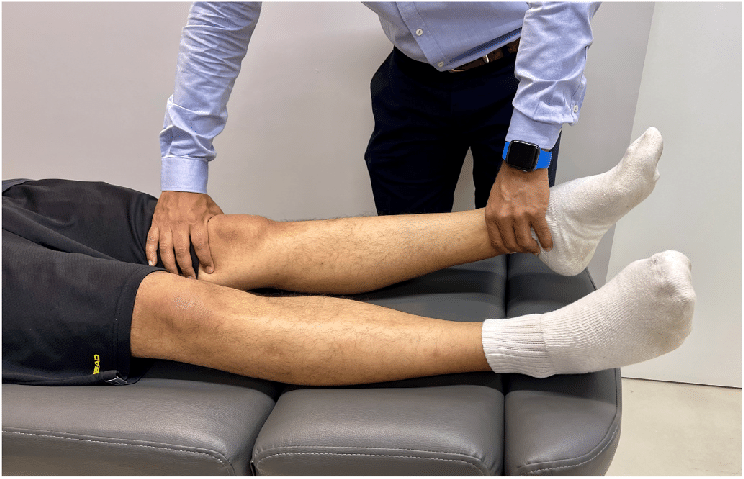Passive Knee Extension Test (PKET)
- Fysiobasen

- Oct 3
- 3 min read
The Passive Knee Extension Test (PKET) is a widely used clinical assessment tool in musculoskeletal physiotherapy. It primarily evaluates knee joint range of motion and the quality of movement, including end-feel. In addition, it is used to measure hamstring flexibility, which is important for identifying injury risk and for monitoring rehabilitation progress [1,2].
PKET is also employed as a criterion for return to activity after anterior cruciate ligament (ACL) injury, especially during the transition from phase 1 (week 1–4) to phase 2 (week 4–8) of rehabilitation [3].

Test procedure
Patient positioning
The patient lies supine on the examination table.
The tested leg is positioned in 90° of hip flexion.
The contralateral leg is kept flat on the table to ensure stability.
Execution
The clinician gradually extends the knee until the patient reports maximum tolerable stretch in the hamstrings.
Hip flexion must be maintained at 90° throughout the test.
Knee angle is then measured using a goniometer.
Goniometer placement
Axis: lateral epicondyle of the femur
Movable arm: directed towards the lateral malleolus
Stationary arm: directed towards the greater trochanter [4,5,6]
Reliability
PKET has demonstrated excellent intra-tester reliability, with ICC values ranging from 0.97–0.98. This makes it a highly reliable test for hamstring flexibility assessment [8].
It has also been shown to be comparable to the Active Knee Extension Test (AKET) for evaluating knee mobility and hamstring tightness [2].
Clinical relevance
Hamstring flexibility is a key factor in both injury prevention and performance.
PKET provides valuable information in cases of hamstring strain injuries and is commonly used during rehabilitation progression monitoring.
In ACL rehabilitation, PKET is an important tool for determining readiness to advance in loading and functional phases.
Conclusion
The Passive Knee Extension Test (PKET) is a reliable and valid clinical assessment for evaluating hamstring flexibility and knee range of motion. Its simplicity, reproducibility, and clinical relevance make it a staple in sports medicine, rehabilitation, and injury prevention. PKET is especially important for monitoring progress after ACL injuries and should be considered in conjunction with other functional assessments for comprehensive evaluation.
References
Fredriksen H, Dagfinrud H, Jacobsen V, Maehlum S. Passive knee extension test to measure hamstring muscle tightness. Scandinavian journal of medicine & science in sports. 1997 Oct 1;7(5):279-82.
Reurink G, Goudswaard GJ, Oomen HG, Moen MH, Tol JL, Verhaar JA, Weir A. Reliability of the active and passive knee extension test in acute hamstring injuries. The American journal of sports medicine. 2013 Aug;41(8):1757-61.Available:https://journals.sagepub.com/doi/10.1177/0363546513490650 (accessed 26.10.2021)
Norton Sports performance Return to play https://nortonsportsperformance.com/wp-content/uploads/Return-To-Play-Knee-2020.pdf (accessed 26.10.2021)
Reurink G, Goudswaard GJ, Oomen HG, Moen MH, Tol JL, Verhaar JA, Weir A. Reliability of the active and passive knee extension test in acute hamstring injuries. The American journal of sports medicine. 2013 Aug 1;41(8):1757-61.
Reese NB, Bandy WD. Joint range of motion and muscle length testing. Elsevier Health Sciences; 2016 Mar 31.
Nelson RT, Bandy WD. Eccentric training and static stretching improve hamstring flexibility of high school males. Journal of athletic training. 2004 Jul 1;39(3):254.
Davis DS, Quinn RO, Whiteman CT, Williams JD, Young CR. Concurrent validity of four clinical tests used to measure hamstring flexibility. The Journal of Strength & Conditioning Research. 2008 Mar 1;22(2):583-8.
Youdas JW, Krause DA, Hollman JH, Harmsen WS, Laskowski E. The Influence of Gender and Age on Hamstring Muscle Length in Healthy Adults. Journal of Orthopaedic & Sports Physical Therapy 2005:35:246-252









